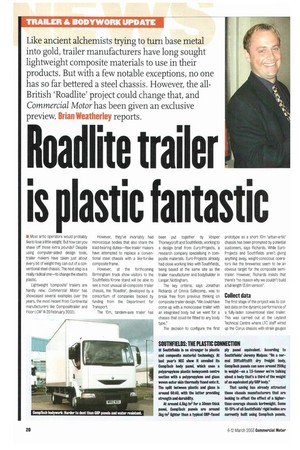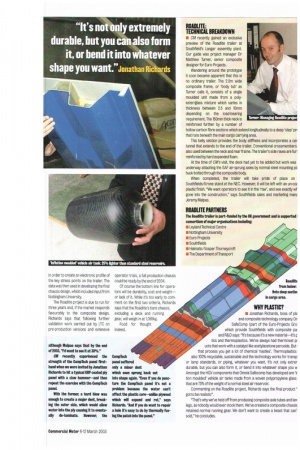Roadlite trailer is plastic fantastic
Page 20

Page 21

If you've noticed an error in this article please click here to report it so we can fix it.
Like ancient alchemists trying to turn base metal into gold, trailer manufacturers have long sought lightweight composite materials to use in their products. But with a few notable exceptions, no one has so far bettered a steel chassis. However, the allBritish 'Roadlite' project could change that, and
Commercial Motor has been given an exclusive preview. Brian Weatherley reports.
m Most artic operators wodd probably fike to lose a little weight. But how can you shave off those extra pounds? Despite using computer-aided design tools, trailer makers have taken just about every bit of weight they can out of a conventional steel chassis. The next step is a really radical one—to change the steel to plastic.
Lightweight 'composite' trailers are hardly new, Commercial Motor has showcased several examples over the years, the most recent from Continental manufacturers like Composittrailer and Floor (CM 14-20 February 2002). However, they've invariably had monocoque bodies that also share the load-bearing duties—few trailer makers have attempted to replace a conventional steel chassis with a like-for-like composite frame.
However, at the forthcoming Birmingham truck show visitors to the Southfields/Krone stand wit be able to see a most unusual all-composite trailer chassis, the 'Roadlite', developed by a consortium of companies backed by funding from the Department for Transport.
The 10m, tandem-axle trailer has been put together by Vosper Thorneycroft and Southfields, working to a design brief from Euro-Projects, a research company specialising in composite materials. Euro-Projects already had close working links with Southfields, being based at the same site as the trailer manufacturer and bodybuilder in Langer, Nottingham.
The key criteria, says Jonathan Richards of Omnia Safecornp, was to break free from previous thinking on composite trailer design, We could have come up with a monocoque trailer with an integrated body but we went for a chassis that could be fitted to any body tYPe."
The decision to configure the first prototype as a short 10m 'urban-artie chassis has been prompted by potential customers, says Richards. While EuroProjects and Southfields aren't giving anything away, weight-conscious operators like the breweries seem to be an obvious target for the composite semitrailer. However, Richards insists that there's no reason why we couldn't build a full-length 13.6m version".
Collect data
The first stage of the project was to collect data on the dynamic performance of a fully-laden conventional steel trailer. This was carried out at the Leyland Technical Centre where LTC staff wired up the Carus chassis with strain gauges in order to create an electronic profile of the key stress points on the trailer. The data was then used in developing the final chassis design, which included input from Nottingham University.
The Roadlite project is due to run for three years and, if the market responds favourably to the composite design, Richards says that following further validation work carried out by LTC on pre-production versions and extensive operator trials, a full production chassis could be ready by the end of 2004.
Of course the bottom line for operators will be durability, cost and weight— or lack of it. While its too early to comment on the first two criteria, Richards says that the Roadlite's bare chassis, excluding a deck and running gear, will weigh in at 1,065kg.
Food for thought indeed.




































































































































































